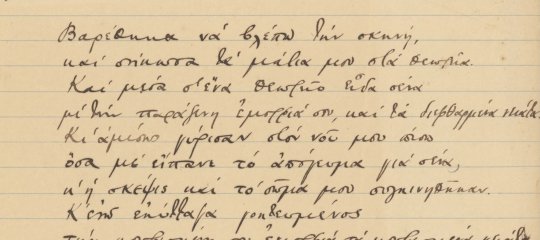ΔΕΚΑΟΧΤΩ ΛΙΑΝΟΤΡΑΓΟΥΔΑ ΤΗΣ ΠΙΚΡΗΣ ΠΑΤΡΙΔΑΣ - Φλώρα Μόλχο
ΔΕΚΑΟΧΤΩ ΛΙΑΝΟΤΡΑΓΟΥΔΑ ΤΗΣ ΠΙΚΡΗΣ ΠΑΤΡΙΔΑΣ
Mουσική:Μίκης Θεοδωράκης, Στίχοι Γιάννης Ρίτσος
ΑΝΑΒΑΦΤΙΣΗ
Λόγια φτωχά βαφτίζονται στην πίκρα και στο κλάιμα,
βγάζουν φτερά και πέτονται-πουλιά και κελαϊδάνε,
Και κειος ο λόγος ο κρυφός-της λευτεριάς ο λόγος,
αντίς φτερά βγάζει σπαθιά και σκίζει τους αγέρες.
ΚΟΥΒΕΝΤΑ Μ’ΕΝΑ ΛΟΥΛΟΥΔΙ
-Κυκλάμινο, κυκλάμινο, στου βράχου τη σχισμάδα,
πού βρήκες χρώματα κι ανθείς, πού μίσχο και σαλεύεις;
-Μέσα στο βράχο σύναξα το γαίμα στάλα-στάλα,
μαντίλι ρόδινο έπλεξα κ’ήλιο μαζεύω τώρα.
ΚΑΡΤΕΡΕΜΑ
Έτσι με το καρτέρεμα μεγάλωσαν οι νύχτες
που το τραγούδι ρίζωσε και ψήλωσε σα δέντρο.
Κι αυτοί μες απ’τα σίδερα, μανούλα, κι αυτοί μακριά στα ξένα
κάνουν πικρό να βγάλουν το “αχ”, μανούλα, και βγαίνει φύλλο λεύκας.
ΛΑΟΣ
Μικρός λαός και πολεμά δίχως σπαθιά και βόλια
για όλου του κόσμου το ψωμί, το φως και το τραγούδι.
Κάτω απ’τη γλώσσα του κρατεί τους βόγγους και τα ζήτω
κι αν κάνει πως τα τραγουδεί ραγίζουν τα λιθάρια.
ΜΝΗΜΟΣΥΝΟ
Στη μια γωνιά στέκει ο παππούς, στην άλλη δέκα εγγόνια
και στο τραπέζι εννιά κεριά μπηγμένα στο καρβέλι.
Μάνες τραβάνε τα μαλλιά και τα παιδιά σωπαίνουν
κι απ’το φεγγίτη η Λευτεριά τηράει κι αναστενάζει.
ΑΥΓΗ
Λιόχαρη, μεγαλόχαρη της άνοιξης αυγούλα,
και πού’χει μάτια να σε ιδεί, να σε καλωσορίσει;
Λιόχαρη, μεγαλόχαρη, δυο κάρβουνα στο θυμιατό και δυο κουκκιά λιβάνι
Λιόχαρη, μεγαλόχαρη, κι ένας σταυρός από καπνιά στην πόρτα της πατρίδας.
ΔΕ ΦΤΑΝΕΙ
Σεμνός και λιγομίλητος εθαύμαζε την πλάση
κι η σπάθα τον κεραύνωσε, ποιος λιόντας εβρυχήθη.
Τώρα δε φτάνει του η φωνή, δε φτάνει του η κατάρα
για να λαλήσει το σωστό, του πρέπει καριοφίλι.
ΠΡΑΣΙΝΗ ΜΕΡΑ
Πράσινη μέρα λιόβολη, καλή πλαγιά σπαρμένη
κουδούνια και βελάσματα, μυρτιές και παπαρούνες,
Η κόρη πλέκει τα προικιά κι ο νιος πλέκει καλάθια
και τα τραγιά γιαλό-γιαλό βοσκάνε τ’άσπρο αλάτι.
ΣΥΛΛΕΙΤΟΥΡΓΟ
Κάτω απ’τις λεύκες συντροφιά πουλιά και καπετάνιοι
συλλείτουργο αρχινίσανε με τον καινούργιο Μάη
Τα φύλλα φέγγουνε κεριά στ’αλώνι της πατρίδας
κι ένας αητός από ψηλά διαβάζει το Βαγγέλιο.
ΤΟ ΝΕΡΟ
Του βράχου λιγοστό νερό, απ’τη σιωπή αγιασμένο,
απ’το καρτέρι του πουλιού, τη σκιά της πικροδάφνης,
Κρυφά το πίνει η κλεφτουριά και το λαιμό σηκώνει
σαν το σπουργίτι και βλογά τη φτωχομάνα Ελλάδα.
ΤΟ ΚΥΚΛΑΜΙΝΟ
Μικρό πουλί τριανταφυλλί, δεμένο με κλωστίτσα,
με τα σγουρά φτεράκια του στον ήλιο πεταρίζει,
Κι αν το τηράξεις μια φορά θα σου χαμογελάσει
κι αν το τηράξεις δυο και τρεις θ’αρχίσεις το τραγούδι.
ΛΙΓΝΑ ΚΟΡΙΤΣΙΑ
Λιγνά κορίτσια στο γιαλό μαζεύουνε τ’αλάτι
σκυφτά πολύ, πικρά πολύ-το πέλαο δεν το βλέπουν
Κι ένα πανί, λευκό πανί, τους γνέφει στο γαλάζιο
κι απ’το που δεν το αγνάντεψαν μαυρίζει απ’τον καημό του.
Τ’ΑΣΠΡΟ ΞΩΚΚΛΗΣΙ
Τ’άσπρο ξωκκλήσι στην πλαγιά, κατάγναντα στον ήλιο,
πυροβολεί με το μικρό, στενό παράθυρό του.
Και την καμπάνα του αψηλά, στον πλάτανο δεμένη,
τήνε κουρντίζει ολονυχτίς για του Άη-Λαού τη σκόλη.
ΕΠΙΤΥΜΒΙΟ
Το παλληκάρι που’πεσε μ’ορθή την κεφαλή του
δεν το σκεπάζει η γης ογρή, σκουλήκι δεν τ’αγγίζει
Φτερό στη ράχη του ο σταυρός κι όλο χυμάει τ’αψήλου
και σμίγει τους τρανούς αητούς και τους χρυσούς αγγέλους.
ΕΔΩ ΤΟ ΦΩΣ
Σε τούτα εδώ τα μάρμαρα κακιά σκουριά δεν πιάνει
μηδ’αλυσίδα στου Ρωμιού και στ’αγεριού το πόδι.
Εδώ το φως, εδώ ο γιαλός, - χρυσές, γαλάζιες γλώσσες,
στα βράχια ελάφια πελεκάν, τα σίδερα μασάνε.
ΤΟ ΧΤΙΣΙΜΟ
Το σπίτι αυτό πώς θα χτιστεί, τις πόρτες ποιος θα βάλει
που’ναι τα χέρια λιγοστά κι ασήκωτες οι πέτρες;
Σώπα, τα χέρια στη δουλειά τρανεύουν κι αυγαταίνουν
και μην ξεχνάς που ολονυχτίς βοηθάν κι οι αποθαμένοι.
Ο ΤΑΜΕΝΟΣ
Εδώ σωπαίνουν τα πουλιά, σωπαίνουν κι οι καμπάνες,
σωπαίνει κι ο πικρός Ρωμιός μαζί με τους νεκρούς του
Και πα στην πέτρα της σιωπής τα νύχια του ακονίζει
μονάχος κι αβοήθητος, της λευτεριάς ταμένος.
ΤΗ ΡΩΜΙΟΣΥΝΗ ΜΗΝ ΤΗΝ ΚΛΑΙΣ
Τη Ρωμιοσύνη μην την κλαις, -εκεί που πάει να σκύψει
με το σουγιά στο κόκκαλο, με το λουρί στο σβέρκο,
Νάτη, πετιέται αποξαρχής κι αντριεύει και θεριεύει
και καμακώνει το θεριό με το καμάκι του ήλιου.










